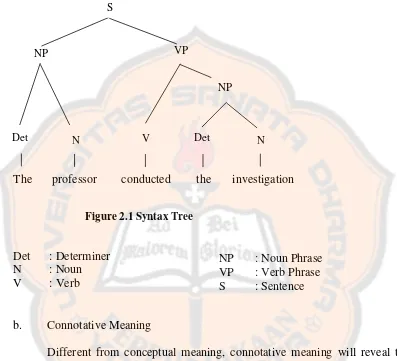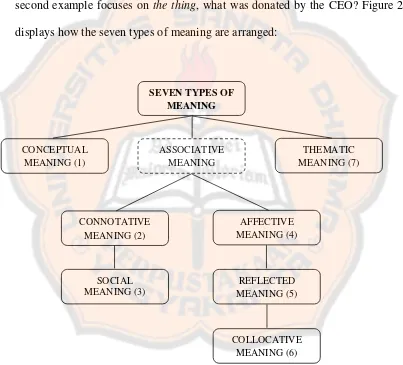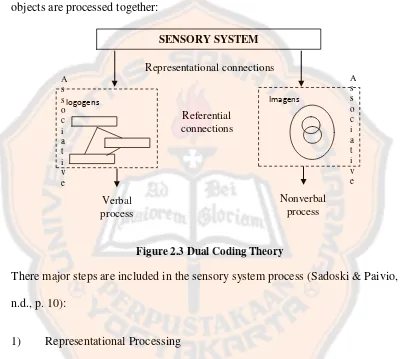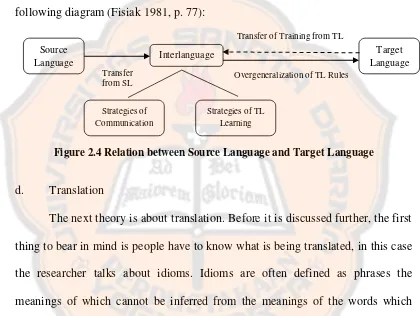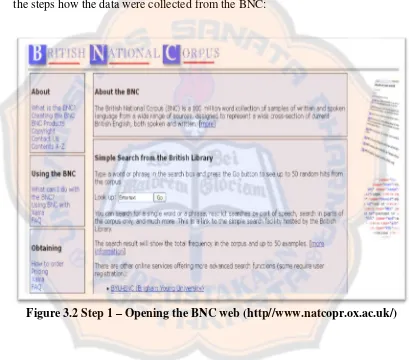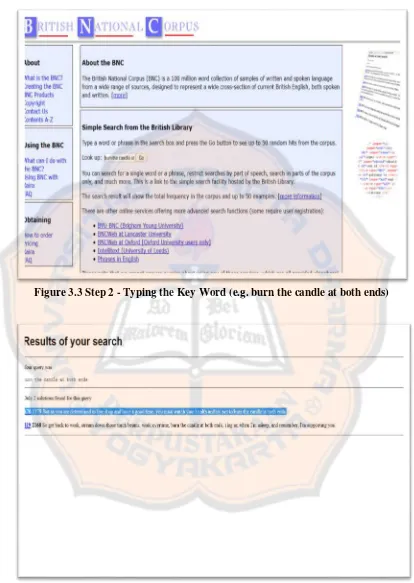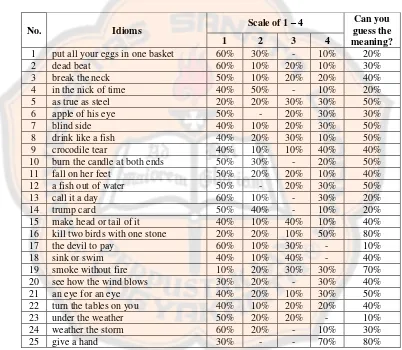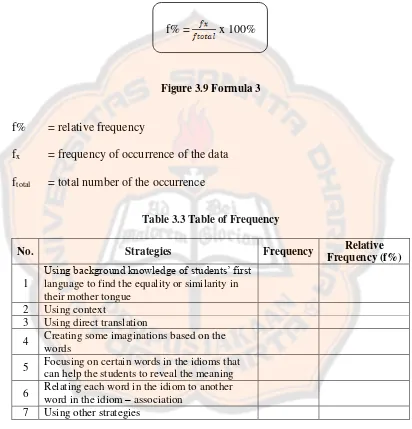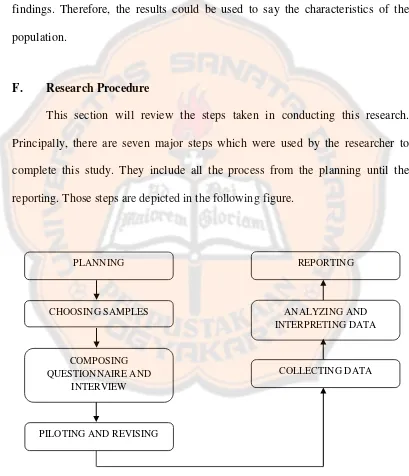1 CHAPTER I
INTRODUCTION
This chapter discusses the introductory part of this investigation. It
encompasses six sections, namely research background, research problems,
problem limitation, research objectives, research benefits, and definitions of
terms.
A. Research Background
Linguistics is a study about language, including how the languages are
used, how the languages are learned, and how the languages always change
(O’Grady & Archibald, 2010, p. 1). Since there are many aspects of linguistics
that can be investigated, linguistics becomes one of the most interesting studies
that will never end. Many studies of languages have been conducted to investigate
many aspects of linguistics under some branches: phonetics, phonology,
morphology, syntax, sociolinguistics, semantics and pragmatics and some other
linguistics studies.
Chomsky (1986, p. 1) states that languages can represent human mind
precisely. It means that their minds can be described through what language they
use to speak and how they speak with the language. Moreover, by using language,
people are able to say things, express their opinions or thoughts, or even transfer
meanings to other people around them (Wardhaugh, 1977, p. 7). Although
languages can be used to express meanings, it is still not easy to define meanings
people tend to think that every word or phrase has exact meanings. In other words,
people can define the meanings by translating word by word. However, the fact is
different. Not all words or phrases can be translated directly, such as idioms.
Since it will discuss more about meanings, this investigation will be conducted
under semantic study.
In linguistics, semantics is the branch which focuses more on the study of
meanings. Etymologically, the word semantic derives from Greek words: sema
which means sign or signal and semaino which means signal or mean (Aitchison,
1978, p. 82). Based on its origin meanings, some experts try to define the meaning
of semantics. Allan argues (2001, p. 1) that semantics is all about meanings in
human languages. Another similar definition also arises from Fromkin (2000, p.
372): semantics is a study of meanings of expressions as one of aspects in
linguistic. By using semantic study, linguists who are learning and investigating a
language want to reveal the meanings and understand why certain words can be
constructed together and semantically acceptable and other words cannot
(Aitchison, 1978, p. 82). And it will lead further to the compositional study as part
of semantic study.
The main issue in this study is about English idioms and strategies to
comprehend the meanings. Therefore, this investigation will not discuss the
general compositional semantics. Instead, the researcher will investigate one of
the exceptional cases of compositionality principle: idiom. Bergman, Hall, and
Ross (2007, p. 253) propose a definition of idioms as the situations where series
meanings but they have fixed meanings. Regular principles here mean when some
words are composed together, they will produce a greater meaning, for example
in: She eats a red apple. By combining the original meanings of each word, the
sentence will make sense and be semantically acceptable. Then, it means a girl
takes round fruit with firm white flesh and red skin into her mouth.
On the other hand, idioms cannot follow the principles of
compositionality. When people say: “I hope you can lend an ear to him”; the
meaning cannot be acquired by putting all together the original meanings from
those words. People cannot say that the meaning of the sentence is you have to
give one of your parts of body used to hear sound to a person because it is not the
intended meaning. Since it cannot be translated directly, it can be said that it needs
more effort to learn idioms. To lend an ear belongs to idiom and it has a fixed
meaning: to listen.
To describe idioms more precisely, McMordie (1909, p. 6) proposes one of
the principles of idioms that is idioms cannot be changed, meaning to say that
there are no words that can be used to replace any words in an idiomatic phrase.
Furthermore, the combination of the words cannot be changed either. If it is done,
it will damage the idioms, such as in the idiom kick the bucket. If people change
the word kick to take or the word bucket to drum, the phrase will no longer an
idiom and it will destroy the fixed meaning.
Perhaps, the idioms mentioned previously are familiar to native English
speakers, but it will be hard to understand even more to guess the meaning for
to learn idioms. English idioms are the examples of special form of language
which are usually used in communication, both written and spoken. English
books, such as novel or poems, use these expressions to convey the authors’
feelings or even to beautify the works. English speakers also often use idioms to
emphasize on something like what it is usually done by Barack Obama through
his speeches, for example. However, the real function of idioms is to help people
to be able to communicate more effectively. Therefore, when it comes to the real
conversation, it will lead both the speakers and the interlocutors to
misunderstanding if they do not understand idioms.
As an English foreign language (EFL) learner, the researcher realizes that
leaning a new language is an ongoing process. People need time to be able to
communicate with a new language. Besides mastering the semantics aspect,
understanding syntactic aspect is also needed in the process of learning the new
language such as word classes and structure. Since idioms belong to the syntactic
structure: included in phrases – fixed phrases, it becomes an essential thing to
comprehend idioms. Moreover, English native speakers also often use idioms and
sometimes they do not realize the situation where that they use idioms in their
speaking. To maintain the conversation goes smoothly, as the English speakers,
English Language Education Study Program (ELESP) students have to be able to
use idioms. However, learning idioms is not as easy as learning other aspects of
language because as it has been mentioned previously, people cannot directly
guess the meanings of the words constructing idioms together. Thus, idioms must
Considering those reasons, it can be concluded that this study is urgent to be
conducted because finally it can be used to find ways to enhance EFL learners’
learning, especially for semester four students of ELESP.
According to contrastive analysis (James, 1980, p. 8), EFL learners tend to
be influenced by their mother tongue in their language learning process. However,
in learning idioms it will not be that helpful to only rely on their mother tongue
because idioms in one language are different from those in another language:
idioms are highly cultural. To refer to the same expression or meaning, for
example, one language will have different idioms compared to another language.
The real example is when people want to refer to the state when there are two
choices but both of them are equally unpleasant; Indonesian people might say
seperti makan buah simalakama. However, English speakers have different
idiom to express it, for example, between the devil and the deep blue sea.
Having seen the examples, it can be said that EFL learners cannot depend much
on their mother tongues to learn English idioms. Although some of English idioms
can be translated into other languages, most of them cannot. That is why, this
study aims to help the students to find ways to reveal the meanings of English
idioms. When the difficulty is solved, then the process of learning will be easier
for them. Finally, in this study, the researcher wants to present the results of
investigating some strategies to process the intended meanings of English idioms
B. Research Problems
There are two problems formulated in this research.
1. What are the major strategies to process the intended meanings of English
idioms?
2. How effective do the strategies lead the semester four students of the
English Language Education Study Program to the intended meanings?
C. Problem Limitation
The limitation is needed in order to discuss the topic thoroughly. This
research is limited to the strategies used to process the meanings of idioms. Since
there are many possible strategies that can be used, the researcher limits the
strategies to using background knowledge of students’ first language to find the
equality or similarity in students’ first language, using context, using direct
translation, creating some imaginations based on the words, focusing on certain
words in the idiom that can help the students to reveal the meaning, and relating
each word in the idiom to another word in the idiom – association. The strategies
are obtained by conducting an interview with participants after distributing the
first questionnaire on the occurrence of idioms.
Moreover, the researcher also limits the study only to some English idioms.
Not all English idioms will be discussed in this study because the point is to find
the major strategies to process the meanings of the idioms. The idioms are taken
from two books of English idioms randomly and to give the idioms contexts, the
data which are taken from people’s daily conversations, it is considered adequate
to help the researcher to gather the data.
The other limitation is on the participants. The researcher chooses semester
four students of ELESP to be the subjects in this investigation. Not all the students
in ELESP will be the population because the researcher wants to discuss this topic
comprehensively. Semester four students are selected because they have been
studying English for two years. This knowledge is considered sufficient for this
investigation. And it will be explained further in Chapter 3.
D. Research Objectives
The researcher conducts this study to achieve two main objectives. First,
the researcher wants to find out major strategies to acquire the intended meanings
of English idioms by semester four students of ELESP. Second, the study is
conducted to reveal the effectiveness of the strategies to lead the students to get
the intended meanings of English idioms. The researcher also hopes by meeting
those two goals, the researcher can give alternative ways for the readers especially
semester four students on how to process the meanings of idioms. Besides, they
can also enhance their ability to learn English as their foreign language through
idioms as part of art of language.
E. Research Benefits
The results of this research can be beneficial for the following language
1. The ELESP Students
This study will provide more information about English idioms for the
readers especially ELESP students. By conducting this research and solving the
research problems, the researcher hopes that this study can help ELESP students
to discover the actual meanings of English idioms. Moreover, it can also enhance
students’ knowledge to learn English as a foreign language. One of the criteria to
say that someone masters a language is when they are able to use the language. If
the ELESP students know how to use and understand the English idioms as part of
English language, it can help them to acquire more ability to use English.
2. English lecturers or teachers
Having conducted this study, the researcher hopes that the English
lecturers or teachers can take some benefits from the results. The study shows that
there are some major strategies which can help the students to comprehend the
intended meanings of idioms. Then, the lecturers or teachers can design such
materials to help the students to improve their knowledge in processing idioms by
using the strategies discussed in this investigation.
3. Future researchers
This paper will be useful for future researchers because they can conduct
further investigation into idioms. If they are interested in conducting the same
study, they can refer to this research design and conduct the same research to get
some confirmations. However, if they are interested in conducting other related
4. Readers
For the readers, this investigation does help because they can use some of
the strategies to help them to understand the meanings of English idioms. By
adopting certain strategies, the readers can enhance their knowledge on
comprehending English idioms.
F. Definitions of Terms
It is crucial to clarify some terms used in this investigation to avoid
misunderstanding. They are presented as follows:
1. Idioms
The researcher uses the definitions proposed by Cruse and Poole in this
investigation. Cruse (1986, p. 37) argues that traditionally, idioms are defined as
expressions that the meanings cannot be guessed from the meanings of each word
which constructs certain idioms. Different from the compositional rules that
people can acquire the meanings of certain phrases by combining the meanings of
each word that builds the phrases, idioms are a special case in which the rules of
compositional cannot be applied. The phrase, pink bag is an example of a noun
phrase which can be defined from each word which shapes the phrase. Pink is a
pale of red color while bag is container made from plastic, leather or other
material and usually used to carry personal things. By knowing the meanings of
each word, people can get the meaning of the phrase. However, when people see
meaning by defining each word. This expression has its own fixed meaning: take
a great risk.
It must be understood that idiomatic expressions, the meanings of which
cannot be acquired from the meanings of each word, will have different intended
meanings when people are forced to do so. Poole (1999, p. 29) also claims the
same thing that idioms are phrases that can only be understood and meaningful
when it is seen as unity.
2. Strategy
Since this investigation discusses the strategies to process the intended
meanings of English idioms by semester four students of ELESP, it means that
this investigation will relate to language learning process. Regarding this reason,
the term “strategy” that the researcher uses will be related to the strategy in
teaching learning process. There are two definitions which will cover the
explanation of strategy in this study. The first is proposed by Latif (n.d., p. 19)
who claims that strategy means actions, procedures, methods, behaviors, steps, or
thought used by the learners to solve problems they encounter in their language
learning process and when they use language. The second definition states that
strategy is a special understanding or behavior that people use to learn new
information (Chamot & O’Malley, 1990, p. 1).
3. Meaning
It is not easy to define what is called by meaning. Although not many
said to them and they can produce meaningful utterances when they are in
conversations. If they do not understand meaning, then they will not be able to
create such conversations. Akmajian, Demers, and Harnish (1988, p. 241) state
that meaning is sort of unit or thing which has its own independence existence. To
make the definition clear, the researcher will give an example: pen. The meaning
of the word pen is a long thin object which is usually used to write or draw with
ink. This definition is supported by Bergman, Hall, and Ross (2007, p. 233), who
say that meaning is things that can be understood, collected, and combined in the
minds of both speakers and interlocutors who use and speak a certain language.
4. Literal meaning
Literal meaning means the basic meaning from certain words. The term
literal which will be used in this study comes from Matthews (1997, p. 743), who
says that literal itself means the meaning of a certain word is based on its letters,
meaning to say that literal meaning does not have imaginative meaning. The
meaning is not based on the context of where the word is used but from the word
itself (original meaning).
5. Intended meaning or figurative meaning
Different from literal meaning, figurative meaning or usually called as
intended meaning which will be used in this investigation is proposed by
Akmajian, Demers, and Harnish (1988, p. 238), who say that figurative meaning
actually refers to something which is different from what the words actually mean.
unpredictable meaning because sometimes the meaning cannot be produced by
combining the meaning of words which compose certain phrases or sentences.
The example of intended meaning is in idiomatic expression such as in a snake in
the grass. Perhaps, some people think that this phrase talks about animal and
plant. However, it actually has a figurative meaning beyond those words which
compose the phrase: dangerous person. This type of meaning will be discussed
13 CHAPTER II
REVIEW OF RELATED LITERATURE
This chapter will reveal some theories which are used in this study. This
chapter only consists of two main sections, namely theoretical description and
theoretical framework.
A. Theoretical Description
1. Related Studies
Some studies were conducted related to the existence of idioms as part of
English language (Rohani, Ketabi, & Tavakoli, 2012; Zarei & Rahimi, 2012;
Bulut & Yazici, 2004; Fotovatnia & Khaki, 2012; Kainulainen, 2006). Research
which was conducted by Rohani, Ketabi, and Tavakoli (2012) investigated how
EFL learners processed idioms. By designing certain steps to accomplish the
purposes of the study, they randomly assigned some students who became the
subjects of the research. First of all, they divided ten students into two groups.
The first group was asked to process the idioms from reading script while the
other group from watching movie. After that, the participants were addressed
some questions related to how they tried to guess the meanings of idioms. Then,
the strategies obtained were used to conduct a survey to a larger population. The
result was the context where the idioms appeared affected how the students
acquired the meanings of the idioms.
Another study on idioms was also conducted by Bulut and Yazici (2004) to
questionnaire to collect the data, they found that the participants used more than
one strategies to reveal the meanings of certain idioms. The investigation also
claimed that as EFL learners, the participants also tried to use their mother tongue
background knowledge to process the meanings of idioms. It is not a surprising
thing because it is well known that learners often try to correlate and use their
mother tongue when they learn a new language, including English as their foreign
language. Moreover, the research showed that the participants also tried to
translate the idioms literally to get the intended meanings. They defined the
meaning of each word which composed the idioms and tried to combine the
meanings to get the whole meanings. Although direct translation could not be
applied to all of English idioms, based on the results of the investigation, the
strategy was used a lot by the participants.
Roselina (2012) also conducted another different study of idioms. In the
research, she focused on idioms which had relation to human body because
according to some sources, those idioms are widely used in people daily
conversation. If in the previous studies the researchers tried to find out the
strategies to process the idioms, Roselina tried to examine the use of
componential analysis to reveal the meanings of certain idioms. The study showed
that by using the componential analysis as the keyword in this research there was
relation between literal meanings and figurative meanings in the process of
acquiring the intended meanings of idioms, in this case the meanings in human
researchers to conduct the same study to see how componential analysis can be
applied to process the idioms about animals, food, or such.
Having read those studies, the researcher got some insights which lead the
researcher to conduct another investigation on English idioms. Since the
researcher is a member of ELESP students, the investigation discusses some
strategies which can be utilized to process the meanings of English idioms. The
investigation will be conducted under semantic study by using linguistics
approach. Moreover, the researcher will use a survey and design some
questionnaires and interview as the main ways to collect the data. And since this
study will be dedicated to ELESP students, the role of the students will be very
useful. Hence, the researcher will choose some students from semester four as the
sample and as the representative of the population.
2. Theories of Meaning
Akmajian, Demers, and Hanish (1988, p. 237) say that language is a
system to carry messages. The messages can be conveyed when the words used in
the communication have certain meanings. However, a sentence can be
interpreted to more than one meanings. There are some factors which can
influence the phenomena such as culture, situation, context, social class, and so
on. Therefore, Leech (1981, p. 9) divides meaning into seven types which aim to
show how those types are suitable for the linguistic communication and also how
they can be approprite for the methods of study conducted to investigate issues in
a. Conceptual Meaning
Conceptual meaning sometimes is also called denotative meaning or
cognitive meaning. It will reveal meaning in a logical way. There are two main
principles in interpreting the meanings of certain words, phrases or even sentences
by using conceptual meaning as the approach; they are the principle of
contrastiveness and the principle of structure.
According to contrastiveness principle, meaning can be acquired by using
componential analysis: people give label to a word, whether it is positive or
negative based on certain features. The following are the examples of using
principle of contrastiveness:
i. woman : [+human] [-male] [+adult]
ii. boy : [+human] [+male] [-adult]
By looking at the differences of the features, people can distinguish the meaning
of the word woman and boy. Hence, woman is an adult female human; while boy
is a young male human. Basically, the meaning is only seen from the features of
which a certain word possesses.
The other principle is based on the structure. According to the theory,
larger linguistic units are built up out of smaller units. People can determine the
meaning of a sentence, for example, by analyzing the words which construct the
sentence. By using syntax tree, each word (smaller unit), is given a label whether
is a determiner, verb, noun, adjective, preposition, or other features. After that,
some lines will be made to indicate that the smaller units will be constructed to
noun. It is done until the sentence is made up. This process can be illustrated with
the syntax tree depicted in the following figure.
The professor conducted the investigation
Figure 2.1 Syntax Tree
Det : Determiner N : Noun V : Verb
NP : Noun Phrase VP : Verb Phrase S : Sentence
b. Connotative Meaning
Different from conceptual meaning, connotative meaning will reveal the
meaning of an expression through its virtue of what it refers to. Principally,
connotative meaning does not stand alone; it is influenced by other aspects such as
culture, history and individual experiences and such. The example is idiomatic
expressions. Idioms have connotative meanings which sometimes the meanings or
the idioms are affected by a certain culture or history. The expression an eye for
eye, for instance, is the result of history. This expression is an adaptation of the
Holy Bible: ‘Eye for eye, tooth for tooth, hand for hand, foot for foot’ NP
S
VP
NP
(Deuteronomy, 19, 21) and the connotative meaning of the idiomatic expression is
retaliation of an equal ferocity (Collins, 1966, p. 70). Another example is as easy
as pie which means extremely easy. This idiomatic expression is influenced by
culture, especially American culture because pie is one of food from America.
c. Social Meaning
The next type is social meaning in which the language is affected by social
circumstances. Social meaning is closely related to where the utterance is taking
place because the environment will give some impacts on the meanings. The real
example is the use of word which is influenced by social class. People recognize
the word home as a place where somebody lives. However, there are also other
words which have the same meaning such as domicile, residence, and abode.
How do they differ? Perhaps, many people assume that those words are
synonymous, but by using social meaning as the approach, it can be said that there
are no truly synonymous words. Although their meanings are almost similar, in a
certain level, they are different.
iii. domicile - very formal, official
iv. residence - formal
v. abode - poetic
vi. home - general
If true synonym exists, then people may substitute the word home for the
word residence, for instance. However, the meaning will different or even the
sentence will be not acceptable. If people use the word abode in their daily
something related to poetry. Hence, in daily life people usually use the word
home.
d. Affective Meaning
Like other types of meaning which are influenced by other factors,
affective meaning can convey language which is reflected through feelings and
attitudes. They play an important role in determining the meanings of expressions,
besides intonation and voice-timbre. The following are the examples of using
different attitudes to convey one meaning - asking people to be quiet:
vii. I’m terribly sorry to interrupt, but I wonder if you would be so kind
as to lower your voices a little.
viii. Will you belt up!
ix. Can you shut your mouth up?
By using different attitudes, people are able to identify whether the speakers are
showing politeness, impoliteness, displeasure, or friendliness to the interlocutors.
e. Reflected Meaning
Reflected meaning deals with how people may use different words in
dissimilar expressions to refer to the one meaning and one sense. This type of
meaning is often found in poems. To refer to, someone you love, for example,
poets will use different words to carry the same sense, such as a beautiful rose,
the sun of one’s life, and the light in the darkness. Another example is to refer
to the Third Person of the Trinity, people use the expressions such as The
expressions to convey the same meaning, the sense that the interlocutors get is the
same.
f. Collocative Meaning
Collocative meaning consists of the relation of a word which acquires the
meanings of words in a certain environment. The meaning can be produced when
a certain word has relation with another word, for instance:
girl boy
boy man
woman car
x. pretty flower xi. handsome vessel
garden overcoat
color airliner
village typewriter
etc. etc.
g. Thematic Meaning
The last category is thematic meaning which delivers messages in terms of
ordering, focusing, and emphasizing. This meaning is related to grammar
construction which enables the speakers to choose which part of the sentence will
be the focus. Here is the examples:
xi. CEO of Putra Bangsa Inc. donated one million dollars to the
xii. One million dollars was donated by CEO of Putra Bangsa to the
refugees.
Although actually those two sentences have the same meaning, somehow,
different form of sentences, active and passive, will give different attention. The
first example focuses on the doer, who donated one million dollars? While the
second example focuses on the thing, what was donated by the CEO? Figure 2.2
displays how the seven types of meaning are arranged:
Figure 2.2 Seven Types of Meaning SEVEN TYPES OF
MEANING
CONNOTATIVE MEANING (2)
SOCIAL MEANING (3)
AFFECTIVE MEANING (4)
REFLECTED MEANING (5)
COLLOCATIVE MEANING (6)
THEMATIC MEANING (7) CONCEPTUAL
MEANING (1)
3. Theories on Idioms
a. Live and Dead Metaphor
There are two ways to express meanings: literary and figuratively.
However, in some cases, people prefer showing meanings figuratively to showing
meaning literary. This phenomenon arouses a question why do people tend to
convey figurative meanings in their communication. Winterowd (1981, p. 424)
reveals that there are two main reasons behind this phenomenon: the first reason is
figurative expressions are more beautiful and powerful and the second reason is
the meanings can be condensed into figurative expressions than the literal.
Idioms are the examples of figurative expressions used a lot by English
speakers. By using idioms, people are able to avoid saying something displeasure
or impolite directly, but yet the expressions are still powerful to convey the
meanings, such as in: Your dream to study abroad is just pie in the sky. Rather
than saying it is impossible, which sounds more unpleasant, people will try to find
another way to say it by using idioms. Although, actually the message carried is
the same, the sense is different. The language becomes more beautiful but the
power still exists there.
Another example is: He broke the record for the 100-metre race. The
idiom broke the record has compressed meaning to show someone’s
achievement. Rather than using the explanation such as: He did something that
has not been done before or did something better than the best before for the
100-metre race, by using the idiom, the meaning can be condensed. Without giving a
Related to how important figurative expressions in people’s life is, Larson
(1984, p. 249) tries to find the root of idioms as part of figurative expressions. He
claims that actually idioms are metaphors. Hence, he divides metaphors into dead
and live metaphors. Larson states that dead metaphors are part of idiomatic
expressions. In almost all languages, they have idioms as part of their language
and according to Larson; it actually belongs to dead metaphors. Hence, dead
metaphors are part of metaphor which have certain structures and fixed meanings.
It happens because most people usually use the expressions and they become
common words in people’s communication. When people hear certain idiomatic
expressions, they will directly know the meanings and the meanings will not
change for sure because they have become part of their daily language. Therefore,
people cannot create their own idioms and adjust the intended meanings.
On the other hand, live metaphors belong to expressions which are made
on the spot by the speakers in order to make the conversations clearer by giving
some illustrations through comparisons (Larson, 1984, p. 249). Unlike dead
metaphors, people can make their own live metaphors because they do not have
certain structures or formations. As long as the comparisons which are made by
the speakers are clear and understandable, then the expressions can be called as
live metaphors or metaphors. In terms of meaning, people can interpret and adjust
the meanings of live metaphors.
To make the differences between dead and live metaphors clearer, the
researcher gives some examples as follows:
xiv. She is wasting my time.
When people read the first example, they will directly know the meaning
of the statement because the words in bold have their fixed meaning: it is too late
for you to study linguistics. As said by Larson (1984, p. 249), people will no
longer think about the comparison used in the statement because dead metaphors
or usually called as idioms has its own structures. People cannot change the
formations of the words, for example changing the word high into low. If the
change is made, the expression will be no longer an idiom.
However, it is different from the second example. In order to acquire the
meaning, people have to make some analyses by understanding the comparison
and then try to interpret the meaning. Unless they are able to identify the
comparison made in the statement, they will not be able to get the intended
meaning. Statement number two actually tries to compare money and time. The
word waste is usually used when people are talking about money. However,
because time and money are equally important, people try to substitute the word
waste in order to get the feeling of how important time is. Having identified the
comparison why the word waste is used in that case, interpreting the meaning is
no longer difficult: using the time unwisely. Live metaphors will be understood
only after both the speakers and the interlocutors pay special attention to the
comparisons which are made in the statements (Larson, 1984, p. 249).
b. Definitions of Idioms
Having discussed live and dead metaphors, it brings the researcher to
originated from metaphorical expressions but going through some processes that
they became frozen in their forms and meanings. When people hear idiomatic
expressions, especially English native speakers, they will no longer think about
how to process the meanings of the English idioms. They are already accustomed
to the forms and the meanings because both will surely not change. Unlike
idioms, metaphors need a certain process in acquiring the meanings. Even for
English native speakers, they need time to reveal the meanings because metaphors
can be created by anyone in any situation. Therefore, making some imaginations
and relating experiences to the metaphors will help people to find the intended
meanings.
Discussing what actually idioms are, a deeper explanation is proposed by
Fromkin Blair and Collins (1993, p. 181) who give the researcher more
understanding on what idioms are. They say that idioms are actually like other
phrases; however, they tend to be frozen and do not allow any words to change
their structures or replace certain words in the idioms. Further, idioms also break
the semantic rules which state that words can be combined together if they share
the same semantic properties. For example, the object of eat is usually followed
by something edible, but in these idioms:
xv. He ate his hat.
xvi. Eat your heart out!
The semantic properties are violated. Those examples show that idioms have
non-native English speakers have to learn these restrictions well to avoid
misunderstandings.
In a new definition proposed by Fromkin, Rodman, and Hyams (2003, p.
205), they try to add more information about the definition of idioms which are
not clearly explained in the previous definition. They claim that idioms are
actually fixed phrases. Since they are called as phrases, they must consist of more
than one words. However, in terms of meaning, the meanings of idioms cannot be
deduced from each word and it becomes the reason why idioms break the
principles of compositionality. Usually, by using the compositionality principle,
people will be able to infer the meanings of phrases or sentences by combining the
meanings of each word which composes them. Nevertheless, idioms have fixed
meanings and they must be learned.
c. Pure Idioms, Semi-idioms, and Literal Idioms
Idioms are phrases which can only be recognized as one unit – the words
which compose the idioms will have different meanings when they stand alone.
Therefore, non-native English speakers have to realize this constraint. Besides
their special characteristics, idioms sometimes are also expressions which can
represent a certain history or culture (Poole, 1999, p. 29). In, for example, parle
français comme une caxhe espagnole (speaking like Spanish cow), this
expression will be used by French to say if a person cannot speak French well.
Another example is se hace el sueco (making himself the Swede) which is used by
Considering the existence of idioms which are used by people to help them
to express certain feelings, Fernando tries to divide the idioms into some classes:
pure idioms, semi-idioms, and literal idioms. Pure idioms are traditional and
ordinary idioms, such as spill the beans. In the example, the actual meaning of
the idiom has nothing to do with beans, instead, it means to tell someone secret
information. However, people, especially native English speakers will
automatically know the expression and the meaning because it is conventionalized
(Fernando, 1996, p. 35).
On the other hand, semi-idioms are idioms which consist of one of more
literal words and at least one non-literal or figurative word, and the formation
cannot be replaced by other words (Fernando, 1996, p. 36). For instance the idiom
foot the bill, which means to pay, it has one literal (bill) word and one non-literal
word (foot). The other examples are in the blue film or blue joke. People call
them as semi-idioms because they consist of both literal and non-literal words. By
understanding non-literal word, people may be able to guess what meanings will
be about and try to relate the literal word and non-literal word. The meaning of
blue is not a type of colors. Therefore, they still belong to idiom because the
meanings cannot be guessed directly although people can expect that the
meanings will be related to film or joke.
The last class of idioms proposed by Fernando is literal idioms. Such as on
foot and on the other hand, they belong to literal idioms because they are
noticeable and limited to only certain variations (Fernando, 1996, p. 36). They are
called literal idioms because actually they consist of literal words, however, still,
expressions. In, on the other hand, which means showing comparison, the
meaning has nothing to do with hand. Hence, it belongs to idiom because it has
fixed meaning and fixed expression. Moreover, it cannot be replaced by other
words such as foot or leg. If the changes are done, it will be no longer an idiom.
Although it is possible to divide idioms into some classes, it is still difficult
to keep the strict rules. Perhaps some people think that certain idioms belong to
pure idioms, but other people might say that they belong to semi-idioms or literal
idioms. This fuzziness does not only happen to the idioms – categorizing the
idioms into some classes, but also in other aspects of languages (Fernando, 1996,
p. 37). Consequently, people have to realize this phenomenon and be more aware
of this occurrence.
d. Types of Idioms
Idioms are inseparable phrases the components of which cannot be varied
(Fernando, 1996, p. 30). Moreover, only certain phrases which conventionally
have fixed structures and lexical items acquire the status of idioms. This
explanation will bring to another aspect of English idioms: types of idioms. Seidl
and McMordie (1980) split English idioms into seven major types. The following
are the combinations of adjectives and/or nouns which form the idioms:
1) Pairs of adjectives
This type consists of two adjectives. Usually, the adjectives are separated
by conjunction such as and, but, and or. Here are the examples of pairs of
adjectives:
e.g. Both ancient and modern men have been fond of waging war.
b) Black and blue: bruises
e.g. Mary has fallen down the stairs again-she is black and blue all over.
c) Through thick and thin: through all dangers and difficulties
e.g. Jack and Jim went through thick and thin together in the last war.
2) Pairs of nouns
The next type is idioms which consist of pair of nouns. Like the previous
type, this idiom is also connected by conjunctions.
a) Alpha and Omega: the beginning and the end, the first and last
e.g. She loves her parents very much. They like alpha and omega for her.
b) Hole and corner:secret
e.g. I don’t want hole and corner business meeting anymore, from now on
every meeting will be open.
c) Skin and bone: very thin
e.g She is just skin and bone.
3) Collective noun phrases
These idioms consist of collective noun phrases – they have different way
to refer to a group of something. It will be difficult to be guessed by non-native
English speakers because a certain group has different collective noun.
a) A colony of ants
e.g. There is a colony of ants under the dining table.
b) A flock of sheep
c) A pack of wolves
e.g. A pack of wolves attacks the hunters in the forest.
4) Compound adjectives
Compound adjective idioms consist of the combination of words which
function as adjective.
a) A hit-and-run: driver, a driver who drives away after causing an accident
in which there is material damage
e.g. A hit-and-run driver caused many troubles for other riders.
b) A nine-to-five: job, a job in which the working hours are from nine in the
morning to five in the afternoon
e.g. A nine-to-five job is not recommended for students to be their side
job.
c) A round-the–clock: service, a service which is offered continuously, all
day and all night
e.g. A round-the-clock service is almost offered by all companies
nowadays.
5) Adjectives + noun phrases
These idioms comprise adjectives and nouns to compose fixed phrases
which also have restricted meanings.
a) A big shot: an important person
e.g. Mr. Baskoro is a big shot in business and politics.
b) Flying colors: to accomplish something with great success
c) The seventh heaven: to be extremely happy
e.g. Since she finished her thesis, she has been in the seventh heaven.
6) Noun phrases
The next type deals with idioms which encompass some noun phrases to
construct an idiom.
a) The apple of one’s eye: someone is very dear to one
e.g. Wulan is the apple of her father’s eye among her sisters and brothers.
b) A fish out of water: a person who feels uncomfortable in his present
surroundings
e.g. Marco becomes a fish out of water in his new office.
c) A snake in the grass: a person who pretends to be a friend but who at the
same time is secretly damaging one
e.g No one wants to take Anne as a member of team because she is well
known as a snake in the grass.
7) Proper names made up of an adjective and a noun
The last idioms deal with names which are usually used to refer to certain
places or countries. When people use these names, they will directly represent the
places people refer to. No other way to guess which places are meant by the
speakers except by knowing and learning them.
a) The Big Four: the four major banks in Britain: Barclays, Lloyds, Midland
and National Westminster
e.g. The Big Four is recognized as the former of economic growth in
b) The Eternal City: Rome
e.g. The Eternal City has become one of the most visit destinations for
tourists around the world.
c) The Third World: developing countries which are not politically aligned
to either the East or the West
e.g. Since the Second World War, Indonesia has belonged to the Third
World.
4. Theories on Processing the Meanings of Idioms
a. Influencing Factors in Comprehending Idioms
Since English idiom is one of the most difficult parts of English language,
it needs more effort for non-native English speakers to learn them. For native
English speakers, acquaring the fixed meanings of idioms is not a big problem
because they are already accustomed to the idiomatic expressions, but for
non-native English speakers, especially ELESP students, they need some strategies to
help them to reveal the intended meanings. Therefore, the researcher presents
discussion on three major factors which should be considered in comprehending
idioms because the success of learning idioms will be affected by these three
aspects; namely transparency, familiarity, and context.
1) Transparency
The first factor is related to the trasparency of idioms. Moreno (n.d., p.
394) defines transparency as degree in which the meanings of idioms can be
determined by the information offered by the idioms to help the hearers or the
are, the more accessible for people to reveal the actual meanings of idioms. The
amount of information in the idioms actually can tell people the intended
meanings. Hence, the degree of transparency will determine how people may
access the literal meanings of idioms, as in:
xvii. Zee breaks his father’s heart when she failed the examination.
xviii. We are all in the same boat, so don’t take all the responsibilities by
yourself.
xix. Stop beating around the bush. You can directly tell me if you
don’t want to help me.
Those three examples show how the degree of transparency will help
people to acquire the meanings of idioms. In the first example, it is possible to
guess the meaning when people know the meaning of each individual word which
composes the idiom. The words can be associated with the whole meaning of the
idiom. In this case, the meaning of break one’s heart can be hurting one’s
feeling. Hence, people can draw conclusion from the associated meaning that the
idiom actually expresses making someone disappointed.
However, the process will be different when people try to acquire the
meaning of the second example. In, in the same boat, the meaning is not as
transparent as in the first example. Although it is a bit difficult compared to the
first example, the information in the idiom can still help people to process the
meaning. If it is examined clearly, there is one literal word that actually tells the
meaning – the word same. By using this word, people can associate the meaning
that the meaning is in the same position. The amount of information can tell
people the meaning behind the words which compose the idiom.
The last example is the most difficult idiom because the meaning is hard to
be processed due to the very low degree of transparency. In beat around the
bush, it is impossible to use the information in the idiom to get the meaning
because it tells nothing. There is no relation between beat around the bush and
avoid giving direct answer. For that reason, degree of transparency is one of the
essential factors in comprehending idioms. At last, Moreno (n.d., p. 405) states
that the mutual relation between processing the meanings of idioms and the
degree of transparency are not merely about finding alternative ways to find the
meanings of idioms, but how people may able to reveal the meanings based on the
information given by the idioms.
Rohani, Ketabi, and Tavakoli (2012, p. 105) have their own explanation on
the degree of transparency; they point out that the degree of transparency of
certain idioms will match with the images or pictures when people try to depict
the idioms. They use the example of go by the book which has high transparency
because it implies the literal meaning – follow the instruction on the book directly
and can be easily associated by the non-literal meaning or the connotative
meaning - to follow the rules or regulations. In conclusion, it can be stated that
degree or transparency is about how literal meaning and non-literal meaning can
be used to reveal the meanings of idioms (Rohani, Ketabi, & Tavakoli, 2012, p.
2) Familiarity
Another important factor in understanding idioms is familiarity which has
strong relation with the occurrence of idioms in a language. Rohani, Ketabi, and
Tavakoli (2012, p. 105) claim that the meaning of familiarity is about the
frequency of the existence of idioms in a certain language. The degree of
familiarity will influence people in understanding the meanings of idioms. When
certain idioms have high degree of familiarity, it will be easier for people to
process the meanings and vice versa when certain idioms have low degree of
familiarity, it will be rather difficult for people to digest the meanings because
how they will process the meanings when they have never heard the idioms.
The following are the examples of some familiar idioms:
xx. When you have many things to do, just take things easy.
xxi. You can access the information from this website 24/7.
xxii. I usually read novel to kill the time.
The three examples are familiar idioms which are usually used by people in their
daily conversations, especially by native speakers of English. Although not all of
them have high degree of transparency, they do have high degree of familiarity.
Perhaps, almost all people know the meanings of these idioms because they are
accustomed to using or to hearing them. The degree of familiarity will help people
to learn the meanings of idioms (Rohani, Ketabi, &Tavakoli, 2012, p. 105).
Cronk and Schweigert find that familiarity has a strong effect on
comprehending idioms (cited by Kainulainen, 2006, p. 21). They argue that
familiar idioms which have high literalness will be easier to be understood than
process of revealing the meanings. Moreover, unfamiliar idioms which are low in
literalness will affect the speed of the process in acquiring the meanings.
3) Context
The last main aspect affecting people’s understanding in acquiring the
meanings of idioms is context. There is a great difference when people are
assigned to guess the meanings of idioms with and without contexts. People admit
that it is easier for them to acquire the meanings when the idioms occur with
contexts because contexts can help them to guess and associate the meanings and
the contexts. Rohani, Ketabi, and Tavakoli (2012, p. 105) say that idioms are
easier to comprehend when there is strong relation between the idioms and the
contexts where they are used. Since the contexts might offer some information,
people are able to use the information to process the idioms. At least, they have
some imaginations of what the context actually tells about.
Context is essential; it also has an important role especially when the
idioms are neither familiar nor have low transparency (Karuppali & Bhat, n.d. p.
235). Rohani, Ketabi, and Tavakoli conducted a study to investigate the role of
context in processing the meanings of idioms. The result was contexts, where the
idioms appeared, affected how the student tried to acquire the meanings of the
English idioms.
b. Dual Coding Theory
Dual Coding Theory or usually called as DCT is a theory about processing
language proposed by Paivio (1990, p. 53). Basically, this theory claims that in
object and the other system dealing with verbal object (language). Images or
pictures and verbal representation are two different objects which are processed
by two different systems which are completing each other (Ryu, Lai, Colaric,
Cawley, & Aldag, 2000). The following figure illustrates how the two different
objects are processed together:
Figure 2.3 Dual Coding Theory
There major steps are included in the sensory system process (Sadoski & Paivio,
n.d., p. 10):
1) Representational Processing
Representational processing is the first step where logogens are activated.
Logogens are closely related to verbal process. It refers to how people can access
or recognize words (their appearance, sound, and meaning) in writing or speech
and try to relate the words to their mental dictionary because logogens basically
store information needed to retrieve a certain word being search for (“Logogen
model,” 2013).
SENSORY SYSTEM
Imagens logogens
Representational connections
Referential connections
Verbal process
Nonverbal process
A s s o c i a t i v e A
This level only includes the process of recognizing word, whether it is
familiar or not, no further step such as comprehending the meaning. This
activation or recognition depends on the individual itself. One person will have
different stimulus and experiences of the word. The concrete example is in the
process of reading text. When someone encounters a word baseball in a passage,
for instance, there will be some processes of recognition and it will be different
from one individual to another individual due to the differences on their reading
ability, background knowledge, familiarities and so on.
The activation of visual logogens for the word baseball will include the
legibility of the word printed in the text and the context where the word occurs. If
the visually recognition of the word is also familiar with the speech: the individual
are familiar with the word through his auditory system, then phonological
logogens will also be activated quickly without any conscious attention. However,
if the individual is not familiar with the word, and both visual and phonological
logogens are low, then letter combination would be activated: base - ball.
However, if the word is familiar, the recognition process will be fast and involve
higher process: baseball bat.
2) Associative Processing
The second step is associating processing which includes the activation of
the codes and meaningful comprehension. Meaningful associative processing will
include the activation of logogens at least in the morpheme level: for example, in
this process, the individual will try to find the verbal association of a single word
activate verbal association: such as hit, first base, advance runner. In this level,
meaning can be elaborated.
3) Referential Processing
In the last process – referential processing, it involves the activation
between the meaningful comprehension and the codes. In this level, both logogens
and imagens (it is related to non-verbal process. It is about how people can
recognize image or picture in their sensory system) are activated and there is not a
one-to-one referential correspondence. Some logogens might activate some
imagens or even no imagens at all. There is no rule which states that one logogen
will activate an imagen. And in this way, the meaning of language can be defined
and elaborated. Further, it also provides more information to the interpretation:
mental imagery has a useful role in making concrete picture to the meaning and
making sense of it.
In conclusion, DCT is actually a theory which enables the process of both
verbal (language) and nonverbal system (linguistic objects and events) and it is
also related to verbal and nonverbal codes: verbal codes – spoken and written
language; nonverbal – imagery representation of non-verbal objects (Zarei &
Rahimi, 2012, p. 21). By using the codes, the meanings of words can be revealed.
Therefore, according to Zhang, DCT will help the learners in comprehending
idioms because the collaboration between verbal information and mental image in
the idioms will make the learner easier to acquire the intended meanings (as cited
c. Contrastive Analysis
Using the background knowledge of the first language to find the equality
or similarity in the mother tongue is one of strategies used by people to process
the meanings of idioms. It happens because naturally, learning foreign language,
in this case, English, cannot be separated from the influence of the first language.
They will influence each other in a certain way. A theory which discusses how
mother tongue affects foreign language in the learning process is Contrastive
Analysis (CA). James (1980, p. 8) points out that CA is about how first language
influences the way an individual learns foreign language. He emphasizes the
definition of CA on the students’ role. When a student learns a foreign language,
he will use his background knowledge to help him to acquire the new language.
This claim is supported by Ellis (2004, p. 6), who argues that the differences
and/or the similarities between mother tongue and foreign language will interfere
one another and it will help the students to acquire the foreign language.
Unconsciously, either the dissimilarities or the similarities will become the aid for
the students to understand the foreign language. It can be concluded that mother
tongue can function either positively because it will result rapid and easy learning
or negatively because it will result errors.
Realizing the role of CA in the learning process, it will be helpful for
language teachers to prepare some methods to help the students to master a new
language. Fisiak (1981, p. 2) differentiates contrastive studies into two: theoretical
contrastive studies and applied contrastive studies. Theoretical contrastive studies
comparisons. On the other hand, applied contrastive studies deals with the results
of theoretical contrastive studies to provide a framework to offer any necessary
information in teaching, bilingual analysis, translation and so on regarding how a
language influences and helps another language in the learning process. The
mutual relation between the source language and the target can be depicted in the
following diagram (Fisiak 1981, p. 77):
Figure 2.4 Relation between Source Language and Target Language
d. Translation
The next theory is about translation. Before it is discussed further, the first
thing to bear in mind is people have to know what is being translated, in this case
the researcher talks about idioms. Idioms are often defined as phrases the
meanings of which cannot be inferred from the meanings of the words which
construct the idioms. Hence, having understood the definition, it can be concluded
that people have to avoid translating word-for-word when they are translating
idioms (Newmark, 1981, p. 125). However, it is somehow difficult not to translate
idioms word-for-word for EFL learners considering the difficulty of idioms,
although they know that it is not appropriate. One of the interviewees stated that
sometimes he did direct translation to acquire the meanings of English idioms
because he did not have any idea what the idioms were about though he actually Source
Language Interlanguage
Target Language Transfer
from SL
Strategies of Communication
Strategies of TL Learning
Transfer of Training from TL
realized that using direct translation was not suitable to translate the meanings of
idioms. However, by doing so, he said that at least he could make up some
interpretations based on the direct translation.
In translation, people know two different techniques, they are literal
translation (a word-for-word translation which sounds awkward and nonsense)
and idiomatic translation (a translation which tries to transfer the meanings of the
source language to the target language in a natural way) (Larson, 1984, p. 10).
However, there is no truly literal translation or usually called as direct translation.
Most of the translators actually try to modify the translation to make it sound
natural and acceptable in the target language, although the results still do not
sound natural and have different sense in the target language (Larson, 1984, p.
16). The following examples illustrate how the literal translation, modified literal
translation and idiomatic translation occur:
xxiii. Source language : kill two birds with one stone
xxiv. Literal translation : membunuh dua burung dengan sebuah batu
xxv. Modified LT : mencapai dua tujuan sekaligus dalam satu
tindakan
xxvi. Idiomatic translation : sekali mendayung dua tiga pulau terlampui
Every language has idioms and a literal word-for-word translation will not
work. Although sometimes modified literal translation can be used, somehow the
sense created is different from the target language. The examples show the results
clearly. In translating idioms, people will no longer talk about form which should
be kept but rather about how the meanings can be acquired. Although modified
is the best way – finding the equivalence in the target language to have the same
sense and response (Larson, 1984, p. 20).
There are three things which have to be considered in doing translation: 1)
using natural language, 2) transferring as much as possible the meanings from the
source language the target language, and 3) evoking the same sense from the
source language to the target language (Larson, 1984, p. 6).
B. Theoretical Framework
In this chapter, the researcher will discuss the theories that will be used to
answer the main problems in this study. There are two major questions arise
regarding the importance of mastering English idioms by ELESP students.
1. What are the major strategies involved in processing the meanings of
English idioms?
2. How effective do the strategies lead the semester four students of ELESP
to intended meanings?
To answer the research questions, the researcher provides some theories related to
idioms. However, only some theories will be used as the main theories, and others
will be used to support the major theories.
The first problem is about finding major strategies to process the intended
meanings of English idioms. Theoretically, the answer to the question will be
some strategies which are often used by the students. Therefore, in an attempt to
solve the first problem, the researcher uses theories in processing the meanings of
idioms, namely, the three influencing factors in comprehending idioms:
